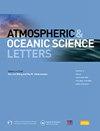GF-4 high-resolution texture and FY-4A multispectral data fusion: Two case studies for enhancing early convective cloud detection
IF 2.3
4区 地球科学
Q3 METEOROLOGY & ATMOSPHERIC SCIENCES
引用次数: 0
Abstract
Early detection of convective clouds is vital for minimizing hazardous impacts. Forecasting convective initiation (CI) using current multispectral geostationary meteorological satellites is often challenged by high false-alarm rates and missed detections caused by limited resolution. In contrast, high-resolution earth observation satellites offer more detailed texture information, improving early detection capabilities. The authors propose a novel methodology that integrates the advanced features of China's latest-generation satellites, Gaofen-4 (GF-4) and Fengyun-4A (FY-4A). This fusion method retains GF's high-resolution details and FY-4A's multispectral information. Two cases from different observational scenarios and weather conditions under GF-4's staring mode were carried out to compare the CI forecast results based on fused data and solely on FY-4A data. The fused data demonstrated superior performance in detecting smaller-scale convective clouds, enabling earlier forecasting with a lead time of 15–30 minutes, and more accurate location identification. Integrating high-resolution earth observation satellites into early convective cloud detection provides valuable insights for forecasters and decision-makers, particularly given the current resolution limitations of geostationary meteorological satellites.
摘要
对流云的早期探测对于降低天气致灾风险至关重要. 当前静止气象卫星受其分辨率的限制, 在预测对流初生 (CI) 时仍存在较高的虚警率和漏报率. 对比而言, 高分辨率的地球观测卫星能够提供更丰富的纹理细节, 有助于提升对流云早期探测的能力. 作者提出了一种创新性的方法, 融合GF-4的高分辨率细节和FY-4A的多光谱信息, 以优化对流云的早期识别和预测. 通过对GF-4凝视模式下两种不同天气条件和观测场景的案例分析, 融合数据在探测更小尺度的对流云方面具有明显优势, 一定程度解决漏报难题, 另一方面能够将对流初生的可探测时间提前, 更精确表现对流爆发位置和更准确刻画对流发展过程. 在当前静止气象卫星分辨率受限的条件下, 这种高分辨率地球观测卫星数据的融合应用能够为气象预报员和决策者提供更有价值的观测视角.
GF-4高分辨率纹理和FY-4A多光谱数据融合:增强对流云早期探测的两个案例研究
对流云的早期探测对于尽量减少危险影响至关重要。利用当前的多光谱地球同步气象卫星预报对流起爆(CI)经常受到高虚警率和有限分辨率导致的漏检的挑战。相比之下,高分辨率地球观测卫星提供了更详细的纹理信息,提高了早期探测能力。作者提出了一种新的方法,该方法集成了中国最新一代卫星“高分四号”(GF-4)和“风云四号”(FY-4A)的先进特性。这种融合方法保留了GF的高分辨率细节和FY-4A的多光谱信息。采用GF-4凝视模式下不同观测情景和天气条件下的2个案例,比较融合数据和单独使用FY-4A数据的CI预报结果。融合后的数据在探测小尺度对流云方面表现出优异的性能,可以提前15-30分钟进行预报,并更准确地确定位置。将高分辨率地球观测卫星集成到早期对流云探测中,为预报员和决策者提供了有价值的见解,特别是考虑到目前地球静止气象卫星的分辨率限制。齐泽聪,齐泽聪,齐泽聪,齐泽聪,齐泽聪,齐泽聪,齐泽聪,齐泽聪,齐泽聪,齐泽聪。对比而言, 高分辨率的地球观测卫星能够提供更丰富的纹理细节, 有助于提升对流云早期探测的能力. 作者提出了一种创新性的方法,融合GF-4的高分辨率细节和FY-4A的多光谱信息,以优化对流云的早期识别和预测。通过对GF-4凝视模式下两种不同天气条件和观测场景的案例分析,融合数据在探测更小尺度的对流云方面具有明显优势,一定程度解决漏报难题,另一方面能够将对流初生的可探测时间提前,更精确表现对流爆发位置和更准确刻画对流发展过程。在当前静止气象卫星分辨率受限的条件下, 这种高分辨率地球观测卫星数据的融合应用能够为气象预报员和决策者提供更有价值的观测视角.
本文章由计算机程序翻译,如有差异,请以英文原文为准。
求助全文
约1分钟内获得全文
求助全文
来源期刊

Atmospheric and Oceanic Science Letters
METEOROLOGY & ATMOSPHERIC SCIENCES-
CiteScore
4.20
自引率
8.70%
发文量
925
审稿时长
12 weeks
 求助内容:
求助内容: 应助结果提醒方式:
应助结果提醒方式:


